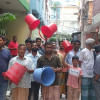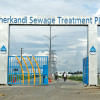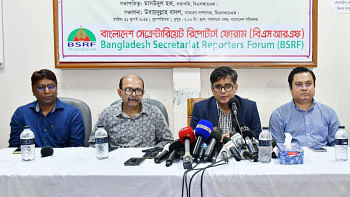‘Supply water looks like sewage’

Jakir Hossain, a resident of Shahjalalbagh of South Dania, has been worried about his four-and-half-year-old daughter who contracted typhoid several months back.
Jakir claimed she got the infection after using the water supplied by the Dhaka Water Supply and Sewerage Authority (Wasa).
“The colour of the Wasa water looks like that of sewage water,” said Jakir, a resident of 1561, Shahjalalbagh, who now has to fetch water from a nearby mosque every day for use by his family.
He claimed he was losing hair and facing allergies as well due to the filthy water.
Jakir’s tale is similar to those of the thousand other residents of Shahjalalbagh of South Dania and parts of East Jurain, both of which have been facing this problem for the last five to six years.
“My daughter went to her office today after suffering from diarrhoea for two days due to the polluted water of Wasa,” claimed Beauty Begum, another resident of Shahjalalbagh on Saturday.
Other tenants in her building have been facing skin diseases and Beauty blamed the sewage like water supplied by Wasa.
“We have to bring water from the nearby mosque giving Tk 2 for a pitcher or a gallon of water and another Tk 10 to the day labourer who carries the water for us,” said Sanowar Hossain, another resident of Shahjalalbagh.
He said they complained to Wasa several times but they paid no heed in this regard.
The crisis isn’t only present in Shahjalalbagh but other areas including Rahmathbagh in Dania, Nabinbagh, Mistir Dokan, Nobarun Gali of East Jurian, part of Shonir Akhra, parts of Shyamoli, Ulon, Kollyanpur and Dolaipar.
“We would not be able to survive if the around 20 mosques of East Jurain and South Shahjalalbagh could not supply fresh water through deep tube-wells,” Shawkat Ali, another resident of Shahjalalbagh, told this correspondent on Saturday.
The quality of water isn’t the only problem. The supply itself is an issue.
Shahida Akhtar of Shahjalalbagh has been without water for the last 10 days.
“I have been fetching water from a mosque to meet up my emergency needs as I am without water for the last 10 days,” said Shahida.
Similarly, Kamrunnahar Ruma, a resident of 111, New Eskaton, said they had been without water for the past 16 days.
It is a 20-year-old problem, she said about water supply going off.
“Our house owner purchases water from a Wasa lorry to meet the demand and all tenants have to pay for this,” she said.
Contacted on Saturday, Managing Director of Wasa Taqsem A Khan said they had decided to carry out an area-based random sampling at Jurain and its adjoining areas to find out the reasons for the polluted water.
“We will take necessary actions after getting the result of the sampling,” he said.
Responding to a report of TIB, Wasa MD Taqsem had said that Wasa water was 100 percent drinkable.
He binned a TIB report that said 91 percent of Dhaka city dwellers boiled the Wasa water to make it drinkable.
Earlier in a unique protest few days ago, residents of Jurain brought lemons, a bag of sugar, and a jar of Jurain’s murky tap water to the Wasa Bhaban in Karwan Bazar to “treat” Wasa MD Taqsem A Khan to a sherbet.
But the MD, who had said Wasa tap water was “100 percent pure”, did not show up for work on the day.
The small group of Jurain residents said they had been getting murky and filthy tap water for decades and the MD’s comment at a press conference a few days ago was a blatant lie.

 For all latest news, follow The Daily Star's Google News channel.
For all latest news, follow The Daily Star's Google News channel. 








Comments